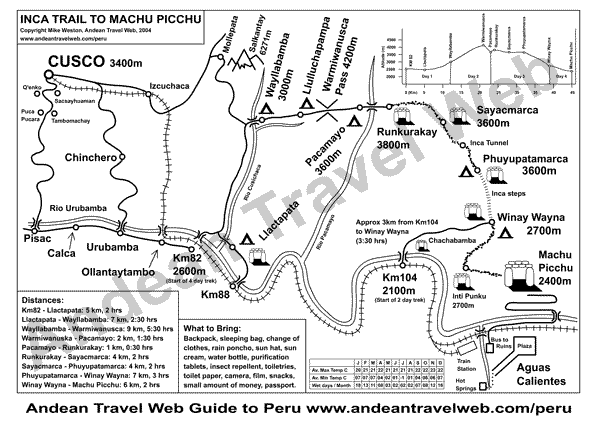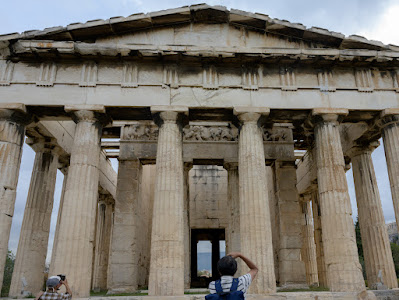Inca Trail - Day 1
 |
| Map of the Inca Trail |
Monday April 15th - Day 1 of the Inca Trail. We had to get up really early and crept out of our hostel to meet the bus at 4.30am.
We were not in the best of health - Mairi had had a stomach upset for a few days and had spent most of the preceding day in bed. I had not slept properly for 3 nights. Naomi seemed Ok, but she was to suffer later on in the trek.
The square was dark and the Llama Path porters, or chatskis as they will be referred to (an Inca term meaning runners) were on hand serving coca tea (we did not indulge as it tastes really bad, although it is supposed to be good for altitude.)
The bus drove us up in to the hills to Ollantaytambo, where we stopped for breakfast. Dawn was just appearing.
 |
| The Chaskis in smart Llama Path gear |
 |
| Early morning Ollantaytambo |
We then drove along by the railway line to Km88 (2,800m - the official start of the Inca Trail. Here we met our two guides - Saul the main man who had excellent English and was very confident, even cocky. His second was Irving a charming quiet man whose English was not so good.
The chatskis sorted out all our gear that they were going to carry. We then walked down to a wooden building where we had to show our passports and permits for the trail. After crossing over the Urabamba River on a suspension bridge, following some donkeys, we were on our way.
 |
| Urabamba River and the trail |
 |
| Naomi near beginning of the trail |
We then came to our first set of Inca ruins. We had reached another river valley - the Cusichaca and the majority of the terracing and buildings lay on the far side of the river. We walked up to an Incan watchtower on our side and sat down while Saul spoke to use about the Incas and their legends.
 |
| Patallacta with the watch tower, Pulpituyoc on the left |
Saul told us that the Incas had originally come to the area from Lake Titicaca led by their king Manco Capac in the 13th century. Here is the legend of the origins of the Incas slavishly cut and pasted from Wikipedia. Viracocha is the creator god. Manco Capac himself is thought to have started the myth to give himself credibility as the son of a god.
According to a myth recorded by Juan de Betanzos, Viracocha rose from LakeTiticaca (or sometimes the cave of Pacaritambo) during the time of darkness to bring forth light. He made the sun, moon, and the stars. He made mankind by breathing into stones, but his first creation were brainless giants that displeased him. So he destroyed it with a flood and made a new, better one from smaller stones. Viracocha eventually disappeared across the Pacific Ocean (by walking on the water), and never returned. He wandered the earth disguised as a beggar, teaching his new creations the basics of civilization, as well as working numerous miracles. He wept when he saw the plight of the creatures he had created.It was thought that Viracocha would re-appear in times of trouble. Pedro Sarmiento de Gamboa noted that Viracocha was described as "a man of medium height, white and dressed in a white robe like an alb secured round the waist, and that he carried a staff and a book in his hands."
In one legend he had one son, Inti, and two daughters,Mama Quilla and Pachamama In this legend, he destroyed the people around Lake Titicaca with a great flood called Unu Pachakuti saving two to bring civilization to the rest of the world, these two beings are`Manco Capac, the son of Inti (sometimes taken as the son of Viracocha), which name means "splendid foundation", and Mama Ocllo which means "mother fertility". These two founded the Inca civilization carrying a golden staff, called 'tapac-yauri'. In another legend, he fathered the first eight civilized human beings. In some stories, he has a wife called Mama Cocha.
The Incas spent years moving west from Titicaca looking for a good place to settle. The came to Cusco where there was already habitation and decided to make it their capital. From here they spread up through the sacred valley, then finally through Peru, Bolivia, Ecuador and in to Chile and Brazil. They taught the local inhabitants how to build using stone and took from them various crafts like weaving. The Incas never invented the wheel or discovered writing. They had an accounting system that consisted of lengths of fibre with knots in, some think that they could have used this for story telling as well.
We walked on up along the course of the Cusichaca river. Around 2.00pm we came to some huts where people were selling drinks and found that there had been a tent set up for lunch. We were not expecting a lot so we were greatly surprised to find that we were served soup followed by a starter and a main course, with lots of lovely salads and vegetables.
 |
| Lunch spot |
The sky began to cloud over on the last part of the journey and there were tremendous views looking back down the valley towards the Veronica glacier. This mountain and glacier tends to dominate the area, The glacier itself is quite small and I guess in a few decades will be non existent.
When we reached camp - Ayapata (3,300m), we were served a snack of biscuits, popcorn (we heard the preparation) and tea and coffee. We were also introduced to all the chatskis. I was so exhausted I went to bed after this and missed the evening meal. However the sleep really did me good and I was in a lot better shape the next day. Mairi also seemed to improve overnight, which was lucky because next day we were to be faced with the two high passes of the trip.
 |
| Ayapata Camp |













Comments
Post a Comment